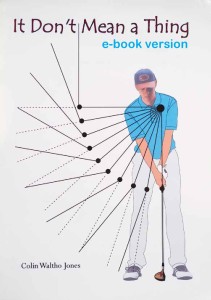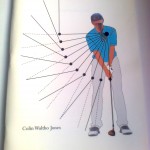21st July 2012
Dear John,
I am writing to you with an exercise that you can use to practise moving between concentration zones and also to practise the type of concentration needed in each zone.
If you remember, I am quite proscriptive about the need to alter your concentration as you move from shot to shot. My recommended routine is:
Zone 1 – This zone starts at the end of the shot. The ball has flown and your fate has been decided. At the beginning of this zone you need to very quickly come to terms with the outcome of the shot. You do this my taking responsibility for every aspect of the shot that got it to where it has ended up: that is, no excuses.
Then you move into a mode of concentration where you are generally aware of your surroundings. You can hear the birds and smell the sea etc. If you get a chance to chat and be social then take it, and use the opportunity to get into the other person’s space. This is the best way to clear your mind of any lingering self pity about your misfortune on the last shot!
This mode of concentration is when your subconscious will be picking up all it needs to know about the conditions: the strength and direction of the wind; the general “wetness” of the course. But it will only be able to do this effectively if you have switched into “chat” mode; if your conscious brain is still fretting about the last shot then the subconscious will not have the space to pick up important peripheral information.
Zone 2 – This starts when you realise that it is about to be your turn to play. It is tempting for most players, I think, to switch into this mode too early because they will have reached their ball and will be keen to get on with their next shot. The timing of the shift into this zone is crucial and takes an amount of determination to try to get it right on each shot.
The reason you want to avoid switching into this zone too early is because it is within this mode of concentration that you will be executing the first part of the routine that will locate your “timing” and get it to go from where it is to where you want it to be – visualisation, and it is much easier holding on to sharp images of flight etc for a short time. (Also, the less time you spend in this zone, the less chance you have of being interrupted: interruptions can be fatally damaging to the shot.)
In this mode of concentration you will be much less aware of your surroundings because you will be using up all the space in your conscious mind with a fully-formed visualisation of your next shot. This visualisation will inform your choice of club, your grip and your stance as you move to stand over the ball. In this mode you are not worrying about the conditions because the subconscious will be furnishing your visualisation with the necessary adjustments from the information it picked up in the previous mode. This stops you forming space-swamping conscious opinions about the wind etc.
Zone 3 – In this zone you drop the visualisation from your imagination and replace it with a sense of the rhythm of the shot. Again, the timing of the shift is crucial because you want the sense of the rhythm of the shot to be as vivid as possible and this can only be done for a short time. [To be only able to concentrate intensely for short periods is a completely natural function of the brain, and it is because it is dangerous to be unaware of your surroundings for too long a period. Well it is if you are crossing the Serengeti; or Oxford Street.]
The exercise
I got the idea for this exercise from an exercise in concentration that I was asked to do at a personal development course I attended some years ago. The beauty of the exercise it that it gets you to concentrate on an activity that we all take for granted: eating.
Working backwards, when the food is in your mouth you are in Zone 3. The swallow is the “shot” and signals the switch back to Zone 1. Getting the food off your plate and into your mouth is Zone 2.
The practise routine goes like this:
- Choose a meal where there is plenty going on around the table
- Do not start the practice routine until you are sure that you are not going to be interrupted by requests to leave the table – put the kettle on, turn the oven off, get another drink etc.
- Take the decision that you are going to play a “shot”. Be aware that you are in Zone 1, that you are in “chat” mode. Notice how you are generally aware of your surroundings and how easy it is to follow what is going on as conversation, movement and actions swirls around the table. At some point, consciously decide that you are going to put a forkful of food into your mouth.
- At that point switch your attention so that you are aware of what is on your plate and what you would like the next forkful to consist of.
- Prepare the forkful and get the food into your mouth as swiftly as is practical.
- Switch your concentration once more and be aware of the sensations of the food in your mouth. Note the heat, the texture, the moistness and the taste. Split the taste up into sweet, sour, salt, spice etc. Make a conscious decision to swallow.
- Switch back into “chat” mode.
Start to finish, the exercise should only take a few seconds. Have a few goes and notice in particular that moment when you decide it is time to take your next “shot”. Notice that it is critical to get the timing of that initial shift out of Zone 1 right because once you have shifted out of Zone 1 then you only have a certain amount of time to complete the actions in Zones 2 and 3.
Notice also how relatively difficult it is to switch from Zone 2 to Zone 3, and how difficult it is to make yourself complete the actions in Zone 3, how there is a natural urge to hurry the process and switch back into the more “natural” and therefore, more attractive mode of Zone 1.
Once you are comfortable completing the exercise (and you haven’t made all your fellow diners stare at you uncomprehendingly), do the exercise again but notice how it applies to the concentration shifts required when preparing to play a golf shot. Notice the destructiveness of interruptions, the difficulty of maintaining concentration for anything other than a few seconds, the rejuvenating effect of being in “chat” mode. Notice also that it is quite a lot of fun being in a state of heightened awareness; and make a particular mental note of the dangers to your golf shot of “taking it all for granted” complacency.
Regards,
Colin


